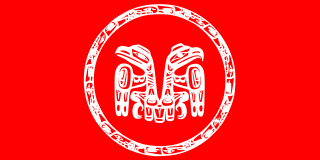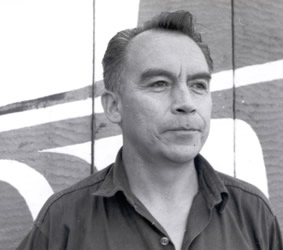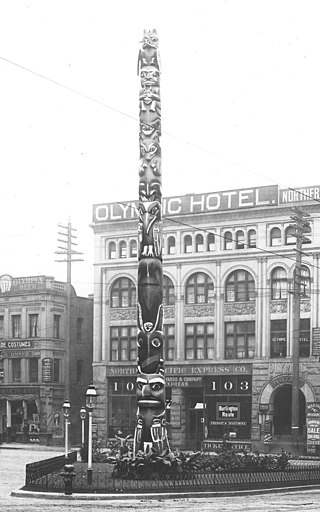Related Research Articles

Haida are an indigenous group who have traditionally occupied Haida Gwaii, an archipelago just off the coast of British Columbia, Canada, for at least 12,500 years.

Totem poles are monumental carvings found in western Canada and the northwestern United States. They are a type of Northwest Coast art, consisting of poles, posts or pillars, carved with symbols or figures. They are usually made from large trees, mostly western red cedar, by First Nations and Indigenous peoples of the Pacific Northwest Coast including northern Northwest Coast Haida, Tlingit, and Tsimshian communities in Southeast Alaska and British Columbia, Kwakwaka'wakw and Nuu-chah-nulth communities in southern British Columbia, and the Coast Salish communities in Washington and British Columbia.
Hydaburg is a first-class city in the Prince of Wales-Hyder Census Area, in the U.S. state of Alaska. The population was 382 at the 2000 census and 376 as of the 2010 census. The name "Hydaburg" refers to the Haida people.

East Montlake Park is a park in the Montlake neighborhood of Seattle, Washington, USA. The park is bounded on the north by the Montlake Cut, on the east by Union Bay, on the south by Washington State Route 520, and on the west by East Park Drive E.
Robert Charles Davidson LL. D. D.F.A., is a Canadian artist of Haida heritage. Davidson's Haida name is G̲uud San Glans, which means "Eagle of the Dawn". He is a leading figure in the renaissance of Haida art and culture. He lives in White Rock, British Columbia.

Charles Edenshaw was a Haida artist from Haida Gwaii, British Columbia. He is known for his woodcarving, argillite carving, jewellery, and painting. His style was known for its originality and innovative narrative forms, created while adhering to the principles of formline art characteristic of Haida art. In 1902, the ethnographer and collector Charles F. Newcombe called Edenshaw “the best carver in wood and stone now living.”

Northwest Coast art is the term commonly applied to a style of art created primarily by artists from Tlingit, Haida, Heiltsuk, Nuxalk, Tsimshian, Kwakwaka'wakw, Nuu-chah-nulth and other First Nations and Native American tribes of the Northwest Coast of North America, from pre-European-contact times up to the present.

Chief Mungo Martin or Nakapenkem, Datsa, was an important figure in Northwest Coast style art, specifically that of the Kwakwaka'wakw Aboriginal people who live in the area of British Columbia and Vancouver Island. He was a major contributor to Kwakwaka'wakw art, especially in the realm of wood sculpture and painting. He was also known as a singer and songwriter.

Henry Hunt was a First Nations woodcarver and artist from the Kwakwaka'wakw people of coastal British Columbia. He carved a number of totem poles which are on public display in Canada and internationally.

David A. Boxley is an American artist from the Tsimshian tribe in Alaska, most known for his prolific creation of Totem Poles and other Tsimshian artworks.

Norman Tait was a Nisga'a First Nations sculptor and totem pole carver from northwestern British Columbia, Canada.

Ellen Neel (1916–1966) was a Kwakwakaʼwakw artist woodcarver and is the first woman known to have professionally carved totem poles. She came from Alert Bay, British Columbia, and her work is in public collections throughout the world.

The Kayung totem pole is a 12-metre (39 ft) totem pole made by the Haida people. Carved and originally located in the village of Kayung on Graham Island in British Columbia, Canada, it dates from around 1850. In 1903 it was sold by Charles Frederick Newcombe to the British Museum, where since 2007 it has been a prominent exhibit in the Great Court.

Totem Bight State Historical Park is a 33-acre (13 ha) state park in the U.S. state of Alaska. It is located north of Ketchikan.

The Nisga'a and Haida Crest Poles of the Royal Ontario Museum are a collection of four large totem poles, hand carved from western red cedar by the Nisga’a people and Haida people of British Columbia's coast. The poles are referred to as: Three Persons Along (Nisga'a); the Pole of Sag̱aw̓een (Nisga'a); the Shaking Pole of Kw’ax̱suu (Nisga'a); and House 16: Strong House Pole (Haida). Each of the crest poles tell a family story, as carved figures represent crests that commemorate family history by describing family origins, achievements and experiences. These memorial poles were typically placed in front of the owners' house along the beach.

The Hydaburg Totem Park is a city park in the small community of Hydaburg, Alaska, located on the western side of Prince of Wales Island in southeastern Alaska. The park is also part of the many parks inside the Tongass National Forest. The park, created in 1939, contains a collection of preserved and recreated totem poles, based on originals collected from small communities abandoned by the Haida people to form Hydaburg. The old totem poles were brought to the park by crews from the Civilian Conservation Corps, and were recreated and preserved under the guidance of Haida master carvers. The park has been the subject of a major restoration effort in the 2010s. The old totem poles, that were removed from the park, remain in outdoor storage near the old cannery in the downtown area of the village.

Stanley Clifford Hunt is a Canadian, First Nations Kwakiutl artist from British Columbia.

The Pioneer Square totem pole, also referred to as the Seattle totem pole and historically as the Chief-of-All-Women pole, is a Tlingit totem pole located in Pioneer Square in downtown Seattle, Washington.
Tim Paul is a member of the Hesquiaht tribe from the Nuu-Chah-Nulth first nation. He is a master carver from Esperanza Inlet British Columbia. He was the senior carver at the Royal British Columbia Museum until 1992 when he left to oversee an indigenous education program for the Port Alberni school board on Vancouver Island.

Jewell James is a Lummi Nation master carver of totem poles, author, and an environmental activist. He is a descendant of Chief Seattle.
References
- ↑ "Hydaburg Totem Park". Cathedral Grove. Retrieved March 10, 2017.
- ↑ "Hydaburg Totem Park". Cathedral Grove. Retrieved March 10, 2017.
- ↑ "House Post". Simon Fraser University. Retrieved March 10, 2017.
- ↑ "I. The Totempolar Region". Alaskool.org. Retrieved March 10, 2017.
- ↑ Dodge, Jeff. "Carving history: CSU scholar studies Alaska's totem pole parks". Colorado State University. Retrieved March 10, 2017.
- ↑ "Seattle, totem pole, Chief John Wallace, Haida art, | Joel Rogers Photography - Northwest Worldwide". Photoshelter. Retrieved March 10, 2017.